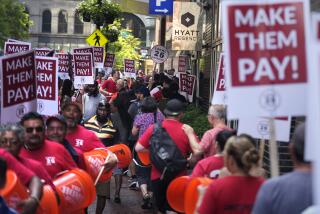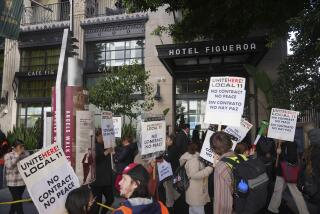Hotels Have Room for Optimism
It was six weeks after the St. Regis hotel in Dana Point opened that terrorists attacked the East Coast, and General Manager Seamus McManus watched helplessly as 3,000 cancellations poured in and occupancy rates tumbled to a dismal 50% for two straight months.
“I’m not going to lie--it hurt,” McManus said. “A lot.”
But November is shaping up to be the turning point, for St. Regis and much of the rest of the industry. Although occupancy rates are still down from year-ago levels, analysts believe the worst is over, noting that last week was the U.S. hotel industry’s best for occupancy rates since Sept. 11--improvements that included upscale properties.
“It’s definitely coming back,” said Brad Garner, an analyst with Smith Travel in Hendersonville, Tenn. “We know where the bottom is and we’re moving further and further away from it. It’s a steady recovery, but it’s just being made in baby steps.”
For the St. Regis Monarch Beach Resort, the turnaround has come after the hotel directed more of its marketing at regional visitors, mailing out thousands of invitations for wine tastings, restaurant promotions and golf and spa discounts to Californians. The rooms have slowly started filling up again.
McManus said this month promises to be the best yet for the $230-million resort, with a 65% occupancy rate expected. The hotel has held firm on room rates, which start at $355 a night.
Of all the segments of the lodging industry, the upscale hotels were the hardest hit by the travel downturn and have been the slowest to recover. A drop in air travel, canceled leisure bookings and especially the sharp decline in business meetings--which luxury hotels count on more heavily than other properties--left many resorts reeling. Nationally, those properties were at their worst in September and October, when occupancies fell to 45% and layoffs were rampant.
In Los Angeles County, the high-end hotel segment fared slightly better than Orange County, posting 54% and 50% occupancy rates, respectively, in September and similar figures in October.
At the Peninsula in Beverly Hills, General Manager Ali Kasikci said the hotel did better than average for October with a 68% occupancy rate. But the five-star, 196-room hotel is on track this month to match its 77% occupancy rate of last year. Kasikci expects to hit the same rate in December.
“Even though we’re not showing any growth over last year, I still feel very good about our performance,” he said.
Occupancy rates last week for all hotel categories were down 7% from the same period a year ago, according to Smith Travel Research, which tracks the hotel industry. In the high-end hotel market, occupancies were down 15% from the same week last year. The latest data showed hotel room revenues at luxury resorts also were down sharply from last year, an indication that daily rates are still being cut to fill rooms.
But the occupancy numbers are still improvements from previous weeks, and hotel operators hope to keep the momentum going by targeting businesses that have opted to hold regional conferences instead of national ones, and by pressing ahead with more localized marketing--both of which seem to be working for the St. Regis.
The resort recently landed two corporate events that had previously been planned as large, national meetings out of state. The first, a Western regional sales meeting for American Express, brought 50 guests to the hotel for three days; the other was a retreat for 50 British Petroleum Oil executives who were originally planning to travel to Texas.
Snaring the regional market has become so important that St. Regis marketing director Brian Dye said resorts are considering different forms of advertising that may otherwise have been discounted.
For example, Dye said resort officials are examining whether they should launch a billboard campaign in the “feeder” markets of Los Angeles, San Diego, San Francisco and Phoenix.
“Prior to [Sept. 11], we probably never would have looked at billboards,” Dye said. “But the rules have changed a little, and we have to look down avenues we didn’t really need to before.”
The Peninsula in Beverly Hills has taken unusual steps to help guests manage the extra chore of traveling these days, Kasikci said. For its most loyal customers, who make up about 38% of its business, the Peninsula will pay to ship their luggage by Federal Express ahead of time so it is waiting for them when they arrive. The hotel has also started packing box lunches from its five-star restaurant that guests can take on the plane when they leave.
“For us, it has been about keeping people coming,” Kasikci said. “In these times, we must practice the art of hospitality like never before.”
At the Ritz-Carlton in Laguna Niguel, General Manager John Dravinsky said “social business”--such as weddings, residents driving in for weekend getaways and last-minute, incentive-based trips where companies wine and dine a handful of their best customers--has boosted occupancy rates.
Although he originally forecast a 55% occupancy rate for November, Dravinsky said a flurry of last minute bookings has pushed the number up to 75%, about 10% less than last year’s rate.
“I’m incredibly encouraged,” he said. “You have to understand, we lost every single group in September and our occupancy was at 47%. So as far as I’m concerned, we’re up. Way up.”
More to Read
Inside the business of entertainment
The Wide Shot brings you news, analysis and insights on everything from streaming wars to production — and what it all means for the future.
You may occasionally receive promotional content from the Los Angeles Times.










